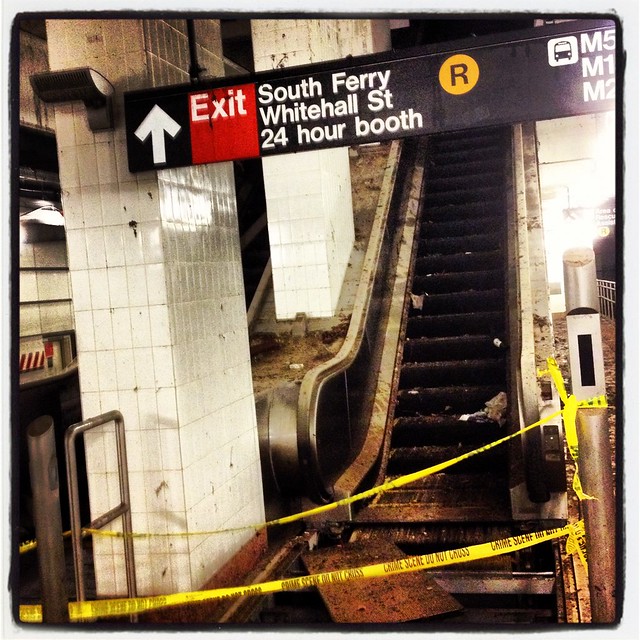
A glimpse of the South Ferry platform shortly after the Sandy floodwaters receded. (Photo via MTA New York City Transit / David Henly)
To repair the South Ferry subway station to its pre-Sandy condition is going to cost a lot. Some — this author for instance — think it may cost too much to do so. Must we spend $600 million on a station we just spent $540 million to construct less than half a decade ago? Still, the MTA isn’t about to give up on the station, and after releasing a funding request breakdown on Monday, MTA officials had more to say about their plans for South Ferry.
Less than two months after the storm, Transit is still hazy on its future plans for South Ferry. The station is expected to be closed for at least another year, and crews are still assessing its condition. Still, as Transit President Tom Prendergast explained during yesterday’s committee meetings, the station may undergo some changes and some improvements. Ted Mann of The Journal had more:
The MTA had previously estimated that it would cost $600 million to fully rebuild South Ferry and the adjoining Whitehall Street station. For the first time Monday, however, Prendergast signaled that work at South Ferry will not necessarily replicate the exact station that sat at the site before the storm.
If the MTA decides that the cost of repairing some parts of the station “aren’t worth that investment or we could use that money elsewhere, we would make that decision along those lines,” Mr. Prendergast said. The twin challenges of rebuilding versus redesigning facilities to better survive future storms can’t be easily separated, he said.
The MTA is not considering eliminating the South Ferry station or moving its footprint. It was rebuilt and expanded in 2009 at a cost of more than $500 million. But some parts of the complex could conceivably be moved elsewhere. One example: the station included a train-dispatch office for the No. 1 line. Such vulnerable equipment could conceivably be moved out of the way of future floods as the MTA decides how to rebuild, Mr. Prendergast said. “If you get a situation where you say, ‘The likelihood of this flooding occurring again is really, really high,’ would you really put this asset back in the same location?” he said.
Not rebuilding the station isn’t an option, and reopening the old five-car South Ferry loop isn’t on the table either. The feds poured $500 million into its construction the first time around and are seemingly prepared to do the same, if not more, this time. Furthermore, the South Ferry station, due to its proximity to the Staten Island ferry, serves as a vital link to Manhattan’s West Side for commuters. It was the 33rd most heavily trafficked station in 2011.
But at the same time, the new South Ferry had flaws. It was built in a flood zone with few protections from a massive, if unexpected, storm surge, and its waterproofing was deficient before Sandy. The MTA can fix these problems by, as The Journal notes, moving key equipment further down the line and repairing inadequate construction work. Whatever the outcome, it’s going to be at least another year, and that in and of itself is something Transit must work to avoid in the future.

 Due to Hurricane Sandy, the MTA’s new Fastrack program suffered a premature end in 2012. The November treatments were canceled as the MTA worked first to restore subway service and then to repair the transit system. Despite this road bump, Fastrack will be back in 2013, and yesterday, New York City Transit unveiled to me the full schedule of work lined up for the coming year.
Due to Hurricane Sandy, the MTA’s new Fastrack program suffered a premature end in 2012. The November treatments were canceled as the MTA worked first to restore subway service and then to repair the transit system. Despite this road bump, Fastrack will be back in 2013, and yesterday, New York City Transit unveiled to me the full schedule of work lined up for the coming year.





 After a series of public hearings last month, MTA Chairman and CEO Joe Lhota has unveiled his recommended fare hike proposal ahead of Wednesday’s board vote. The package of fare hikes across all MTA properties resembles the one
After a series of public hearings last month, MTA Chairman and CEO Joe Lhota has unveiled his recommended fare hike proposal ahead of Wednesday’s board vote. The package of fare hikes across all MTA properties resembles the one